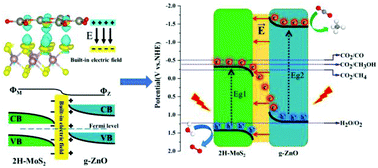The Z-scheme transfer of photogenerated electrons for CO2 photocatalytic reduction over g-ZnO/2H-MoS2 heterostructure†
Abstract
Effective separation of the photogenerated electrons and holes is critical to improve photocatalytic efficiency. To achieve this, we design a Z-scheme g-ZnO/2H-MoS2 heterostructure to spatially separate the photogenerated carriers promoting the reduction of CO2 on the surface of the heterostructure, through density functional theory (DFT) calculations. The g-ZnO/2H-MoS2 heterostructure has a narrow band gap, which is beneficial to speed up the transport of carriers. Simultaneously, the designed heterostructure forms a built-in electric field between the layers to cause band bending, which is very conducive to separate the photogenerated electrons on g-ZnO and the photogenerated holes on 2H-MoS2, and suppress their recombination effectively. Furthermore, the reaction mechanism of photocatalytic reduction of CO2 to CH4 on g-ZnO/2H-MoS2 is studied. The calculation results show that the Z-scheme charge transfer mechanism reduces the barrier of the potential energy control step compared with pristine g-ZnO and 2H-MOS2. Our calculations lay a theoretical foundation for designing and developing high performance photocatalysts for the photocatalytic reduction of CO2.



 Please wait while we load your content...
Please wait while we load your content...